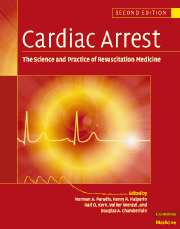Book contents
- Frontmatter
- Contents
- List of contributors
- Foreword
- Preface
- Part I Introduction
- Part II Basic science
- Part III The pathophysiology of global ischemia and reperfusion
- Part IV Therapy of sudden death
- 23 Prevention of sudden cardiac death
- 24 Sequence of therapies during resuscitation: application of CPR
- 25 Transthoracic defibrillation
- 26 Automated external defibrillators
- 27 Public access defibrillation
- 28 The physiology of ventilation during cardiac arrest and other low blood flow states
- 29 Airway techniques and airway devices
- 30 Manual cardiopulmonary resuscitation techniques
- 31 Mechanical devices for cardiopulmonary resuscitation
- 32 Invasive reperfusion techniques
- 33 Routes of drug administration
- 34 Adrenergic agonists
- 35 Vasopressin and other non-adrenergic vasopressors
- 36 Antiarrhythmic therapy during cardiac arrest and resuscitation
- 37 Acid–base considerations and buffer therapy
- 38 Cardiac arrest resuscitation monitoring
- 39 Special considerations in the therapy of non-fibrillatory cardiac arrest
- 40 Cardiocerebral resuscitation: a new approach to out-of-hospital cardiac arrest
- 41 Thrombolysis during resuscitation from cardiac arrest
- 42 Percutaneous coronary intervention (PCI) after successful reestablishment of spontaneous circulation and during cardiopulmonary resuscitation
- 43 Emergency medical services systems and out-of-hospital cardiac arrest
- 44 In-hospital resuscitation
- 45 Complications of CPR
- 46 Bringing it all together: state-of-the-art therapy for cardiac arrest
- Part V Postresuscitation disease and its care
- Part VI Special resuscitation circumstances
- Part VII Special issues in resuscitation
- Index
46 - Bringing it all together: state-of-the-art therapy for cardiac arrest
from Part IV - Therapy of sudden death
Published online by Cambridge University Press: 06 January 2010
- Frontmatter
- Contents
- List of contributors
- Foreword
- Preface
- Part I Introduction
- Part II Basic science
- Part III The pathophysiology of global ischemia and reperfusion
- Part IV Therapy of sudden death
- 23 Prevention of sudden cardiac death
- 24 Sequence of therapies during resuscitation: application of CPR
- 25 Transthoracic defibrillation
- 26 Automated external defibrillators
- 27 Public access defibrillation
- 28 The physiology of ventilation during cardiac arrest and other low blood flow states
- 29 Airway techniques and airway devices
- 30 Manual cardiopulmonary resuscitation techniques
- 31 Mechanical devices for cardiopulmonary resuscitation
- 32 Invasive reperfusion techniques
- 33 Routes of drug administration
- 34 Adrenergic agonists
- 35 Vasopressin and other non-adrenergic vasopressors
- 36 Antiarrhythmic therapy during cardiac arrest and resuscitation
- 37 Acid–base considerations and buffer therapy
- 38 Cardiac arrest resuscitation monitoring
- 39 Special considerations in the therapy of non-fibrillatory cardiac arrest
- 40 Cardiocerebral resuscitation: a new approach to out-of-hospital cardiac arrest
- 41 Thrombolysis during resuscitation from cardiac arrest
- 42 Percutaneous coronary intervention (PCI) after successful reestablishment of spontaneous circulation and during cardiopulmonary resuscitation
- 43 Emergency medical services systems and out-of-hospital cardiac arrest
- 44 In-hospital resuscitation
- 45 Complications of CPR
- 46 Bringing it all together: state-of-the-art therapy for cardiac arrest
- Part V Postresuscitation disease and its care
- Part VI Special resuscitation circumstances
- Part VII Special issues in resuscitation
- Index
Summary
Introduction
The history of CPR is in part documented in the Old Testament, but the science of CPR is but a half century old and is still emerging from its infancy. Accordingly, it is not unexpected and certainly not shameful that as the science of resuscitation goes forward, we must sometimes retreat as often as we advance. Yet, that is indeed progress and inevitably the path that is characteristic of meaningful achievements in science and medicine.
Airway techniques and devices
One size does not fit all
The vast majority of sudden deaths in children and, indeed, in victims under the age of 40 years are attributable to failure of ventilation. Accordingly, either mechanical obstruction by foreign body, laryngospasm, or laryngeal edema, or bronchoconstriction, constrains air exchange. Neuromuscular or skeletal injury, including intrathoracic crises such as pneumothorax, may account for death, though typically not sudden death. It is in these settings that the priority is establishment and maintenance of a patent airway and external ventilation. Since a majority of the foreign bodies that are swallowed by children and adults lodge in the posterior pharynx, the rescuer is the person best prepared to remove these promptly. Hence, the traditional (A) of the ABC survives, especially for children and young adults and in settings of witnessed cardiac arrest when respiratory distress with paradoxical chest and abdominal movements and especially stridor precedes loss of consciousness.
There has been an appropriate re-examination of the role of routine endotracheal intubation during CPR, whether in the field or in the hospital.
- Type
- Chapter
- Information
- Cardiac ArrestThe Science and Practice of Resuscitation Medicine, pp. 809 - 814Publisher: Cambridge University PressPrint publication year: 2007
- 1
- Cited by



